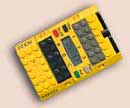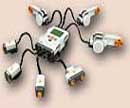 dincer
hepguler robotics page
dincer
hepguler robotics page 
 dincer
hepguler robotics page
dincer
hepguler robotics page 
- Various projects: Mini CNC, Lidar Scanner, Touch Sensitive Robotic Skin, Telescope Mods, Motor Control With Brain Waves, Motorized TimeLapse Rig, Mini IOT Remote, Bat Sonar, Airflow Sensor, Doppler Radar
it was the late 80s and early 90s when i fall in love with robotics... the concept was new and resources were scarse. my first robot was something inside a loudspeaker box, two gear motors salvaged from junkyard, two 12v motorcycle lead acid batteries and some lousy electronics which can let the robot reverse when it encounteres an obstrtuction. i had a vic20 computer which commands the robot via 8channel (4input-4output) rf interface.
Vic20 was the first Apple pc with 20kb (not Megabytes) of memory running on DOS, very slow (1kz) and very incompetent... after years computers evolved and i gained experience. when 2000s came i had the opportunity to work with Lego Mindstorms RCX and nowadays with NXT. amateur robotics exploded with the use of microprocessors and i gained experience with Arduino, a small microcomputer which is used to control inputs from sensors and can command outputs ( electronics, servos and motors) with software programs...
after making many robots wandering around my house, i decided to make one which can wander around the skies freely. UAV stands for Unmanned Airborne Vehicle which implies a robot flying by itself... since some couple of years i am trying to make one from scratch... the project is not easy, it consists of an airborn vehicle which can fly steadily, can be commanded from ground by you, can take some decisions at its own during the flight, must know its orientation as to which way to go, where on earth it is, where is ground and where is north etc... as an hobbyist i sure have an rc aircraft to begin with... the name of my UAV is Gündoğan ( Solar Falcon)...
here is the plan: make an aircraft which can steadily fly...
furnish it with a microcomputer and sensors to interact with environment...
give him enough energy to survive for long periods of time on the air...
in order to reach these goals, i had to work hard and made some experiments. i began with my rc slowflyer but soon i realized that it was insuficcient for the task. i had to make a bigger plane with larger wings, because my small glider was not suitable for carrying all the extra powerbank and computational resources. i needed a gps navigation autopilot and accelometer enabled flight stabilisation. all these electronics and navigation needed extra power and this meant bigger batteries. so i decided to make the plane run on solar power which will backup and charge airborne batteries. the design is simple. the aircraft will be as simple as possible with large wings, very lightweight and versatile. here is the design..
May 2008: my test platform is my 3 channel dragonfly slowflyer. i acquired some flexible solar panels from Iowa Tech Powerfilm which performed exceptionally. i decided to use five 10v 250ma panels which gave me more than 1 amps total for my 400 brushed motor on my slowflyer. actually, the final uav will have 2meter wings which will easily carry the 5 solar panels (100gm total) and it will also be powered by a more powerful brushless motor. in order to regulate the power output i used a simple circuitry comprised of a bank of farad capacitors and a schottky diode. after completing the power needs of the aircraft i concentrated on stabilizing electronics. i used a wii nunchuck accelerometer for the purpose. with some experimenting and carrying on a research on the web, i managed to read nunchuck accelerometer data with my Arduino microprocessor which will let my aircraft know which way is up. next step was embedding a gps navigation to my project. best way is to add a Picopilot autopilot to my system. this is the simplest and cheapest autopilot i could find on the net made by UNAV. later i am planning to use a Nokia N95 8GB as the 'virtual pilot' of my aircraft which has a 3-axis accelerometer and GPS with sirf III chip inside (whose data can be communicated over serial, bluetooth or USB), it has 2 cameras which can transmit real-time video over GPRS and can also run a program for navigation...
July 2008: Prototype mainframe construction is nearly complete... The equipment: Swan 8 channel RC system (5 of it will be used: rudder, elevator, throttle, ailerons and gear switch for enabling autopilot). 7cell 1100 mah 8,4v nimh battery ( i am planning to add a thermistor or mini thermostat to protect the battery from overcharging by 1,25 amp solar panels on long duration flights). single 9gm servo embedded to the wing to control both ailerons which will be controlled by the autopilot for flight stabilization. two 17gm servos controlling the rudder and the elevator via carbon rods which act inside two pipes extending all the way to tail on the bone stick. 115watt brushless in-runner motor with cooler is controlled by art-tech 18amp esc. ( i have a spare 240w outrunner brushless motor and a 50amp esc in case this motor proves to be insufficient). a 11x5 propeller rotated by a 60mm spinner.
the saga continues... i am carrying out ground tests with the equipment and hoping to begin airborne tests before winter ...
Check my other robotics projects : HERE
- Solar bugs and other BEAM robotics...
- Wireless controlled robotic arm...
please e-mail to me at dhepguler@hotmail.com
 A great software to control your Robot... Make it see, talk, move and
interact... MyRobotLab...
A great software to control your Robot... Make it see, talk, move and
interact... MyRobotLab...